When Cristiano Ronaldo swapped the Real Madrid white kits for the black and white stripes of Juventus, he took his massive goal contribution with him.
The first Ronaldo-less season culminated in a 63-goal season for Los Blancos, a 31 goal decrease from the previous season and the club’s worst output of the new millennium. A third-place finish was largely tied to the team’s scoring woes.
Fast forward to the 2019/20 and Los Blancos are once again the champions of La Liga. Though the club is enjoying the spoils of victory, the 70 goals scored, while an improvement upon the previous season, is still a cause for concern. Before the Ronaldo’s departure, Real Madrid’s lowest scoring output of the 21st century was the 66 goals in the 2006–07 season.
Karim Benzema and Sergio Ramos produced career seasons, but no other Madrid player scored even five goals. Given the recent investment at the outside-forward positions, this is a troubling stat.
This data analysis will examine Real Madrid’s muddled group of outside-forwards. Though it’s the deepest part of the team, at least in terms of quantity, there was a staggering void left by the wide players. For a side that emphasises the wide-forwards as much as Madrid, Zinedine Zidane and his staff must identify the most talented and cohesive group of wide players ahead of the 2020/21 campaign. This analysis will use 2019/20 statistics to identify the club’s top performers at the position, using the data analysis as a means of identifying the club’s options ahead of the new season.
Goal Contributions
2017/18 saw Ronaldo 26 goals in 27 appearances while Bale chipped in with an additional 16 goals in 26 matches. Between nine players, the current crop of Real Madrid outside-forwards produced a mere 17 goals in 38 La Liga matches. Though the end result was a title-winning season, statistics show some cause for concern, primarily from the lack of production from the wingers.
One of the beauties of the BBC was the interaction of Ronaldo and Benzema on the left-wing. The Portuguese and Frenchman understood how to manipulate the opposition’s defensive shape to create running lanes behind the defence and open spaces for each other in the box. Add in the streaking runs and pinpoint distributions of Marcelo and you can why Los Blancos dominated the left-flank.
Ronaldo and Bale are cut from a similar mould, each offering past Madrid sides with incredible goal-scoring rates, untracked movements through the opposition’s defensive structure and the ability to beat defenders on the dribble. Looking at the current squad, the only winger who fits that type is Eden Hazard, who also suffered an injury-laden season with minimal production.
To gauge the current group’s goal-scoring statistics, the chart below looks at xG, xG per 90 minutes and goals scored. Our objective is to see which players offered the most total expected goals value over the course of the season while also identifying the contributions on a standard metric. Additionally, since none of the wingers scored more than four goals, our colour-coded points list goal-scoring exploits from zero to four.
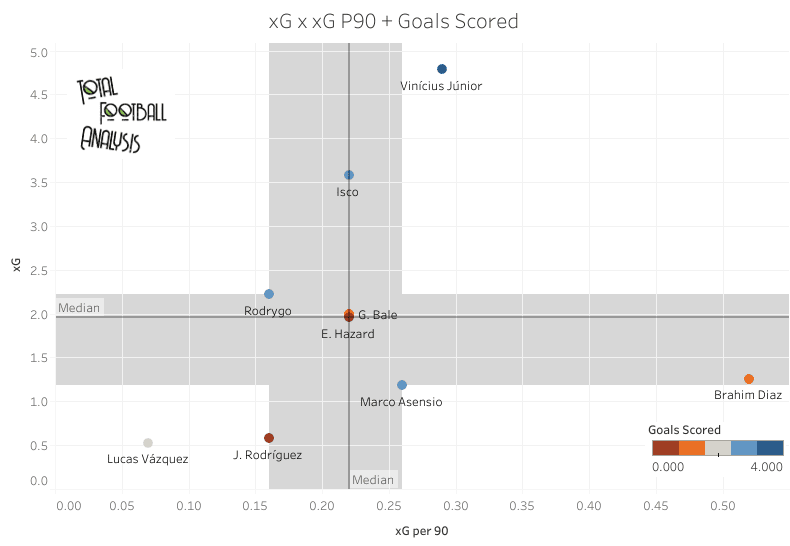
Vinícius Júnior is the standout in the chart. With his four goals on the season, 4.79 xG and 0.28 xG P90, he’s the leader in nearly every category. His one category loss is to Brahim Diaz. In limited action, the young Spaniard registered an impressive 0.52 xG P90, but his 217 total La Liga minutes certainly inflate the total. Marco Asensio’s three goals on 1.19 xG and 407 minutes is certainly impressive. His contributions during the post-COVID-19 suspension were highly influential in the title rally.
Elsewhere, Rodrygo’s three-goal season leaves something to be desired. With just 2.22 xG over 1223 minutes, he wasn’t nearly effective enough during the 2019/20 campaign. It’s tough to judge Isco too harshly in this graph since he’s primarily a playmaker, but this does give a sense of the scoring void coming from his side of the formation. Add in the recurring injuries to Bale, Hazard and Lucas Vázquez and the goal-scoring troubles are better understood.
To contextualise the statistics of Real’s winger, let’s view those same categories in relation to all outside-forwards of the top five European leagues.
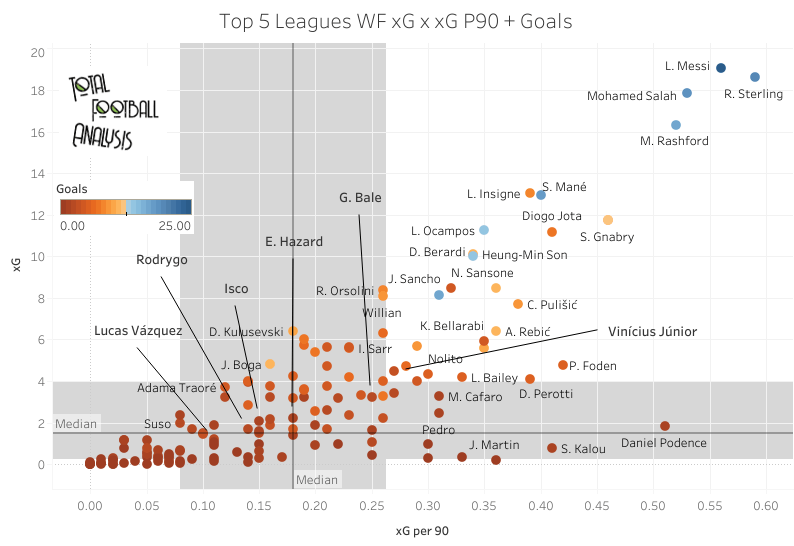
Real Madrid players are mostly highlighted, both in the above image and in all proceeding charts. You do get a sense of how underwhelming a season each player had when viewing their output in relation to many of the world’s top wingers. The cluster at the top right corner represents elite goal-scoring production, but the Real Madrid forwards are far from that region. Vinícius Júnior is the closest to the mark, but he and Bale are at the lower end of the top quadrant. Real’s remaining wingers are just above average in total xG, but below average in xG P90, lost in the sea of burnt orange points.
The next graph highlights key passes P90 by progressive passes P90. Our colour-coded stat is xA P90. Key passes set up shots and expected assists give us an idea of the quality of passes leading to goal scoring opportunities. When a wide forward produces a progressive pass, the result commonly puts a teammate in or near a scoring position, so this graph gives an idea of a player’s effectiveness in setting up teammates.
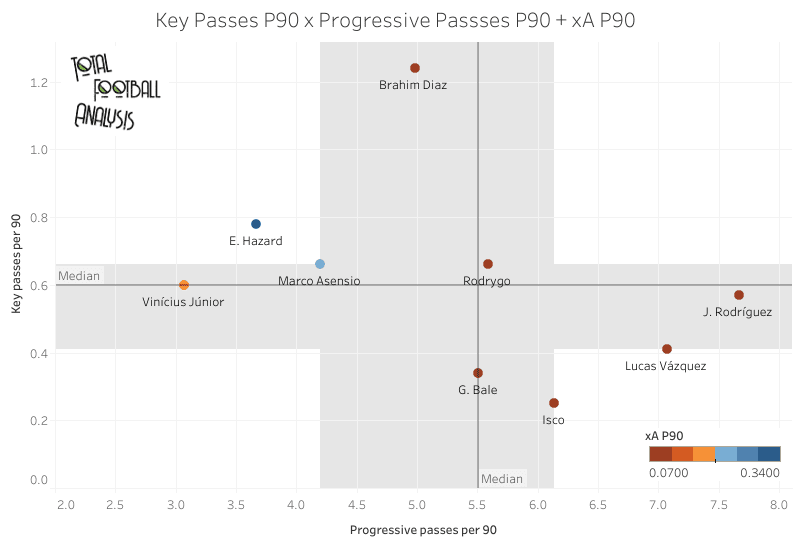
Díaz produces another outlier performance, rating really high in key passes with 1.24 on a per 90 basis, but his 4.98 progressive passes fall behind the pack. In fact, analysis of the chart reveals that James Rodríguez and Vázquez, both players with small sample size, are outliers as well.
Looking at the core group of players, Rodrygo’s 0.66 and 5.59 are the most balanced. Vini (0.60) and Asensio (0.66) just get over the key passes median, but they, as well as Hazard, are well shy of the progressive passes mark. The most important marker in this chart is the colour of the point. Here we see Hazard is well ahead of the rest, registering an average of 0.34 xA P90. Asensio is second with 0.22 xA P90.
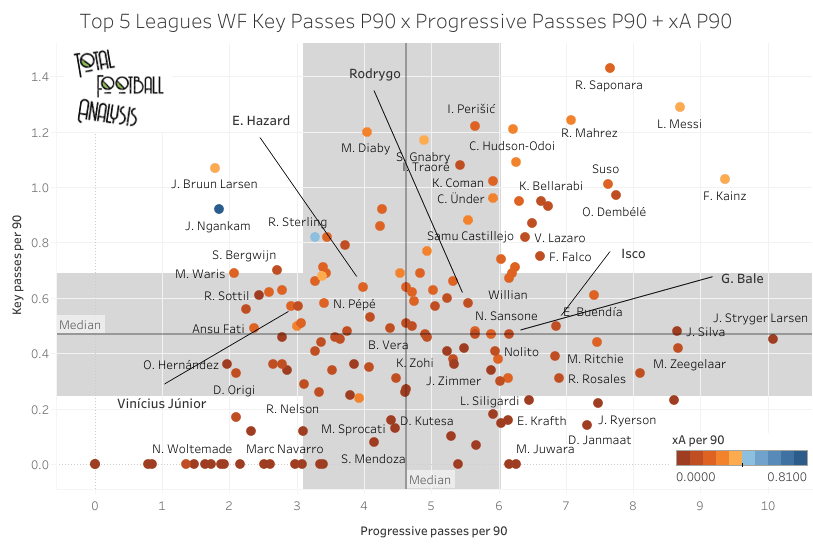
Placing the Madrid players in relation to their counterparts, we again wee that there are no real standouts. Isco does well in progressive passes (6.14) and Hazard is decent in the key passes category (0.78), but, overall not a great showing from the Madrid forwards.
Our final categories for goal-scoring contributions include passes to the penalty area P90, crosses P90 and cross success percentage. Real Madrid’s 729 cross attempts rated third in La Liga. Evaluating the efficiency of those crosses, as well as other passes played into the box, gives us an idea of Real Madrid’s effectiveness in a highly-utilised mode of attacking the box.
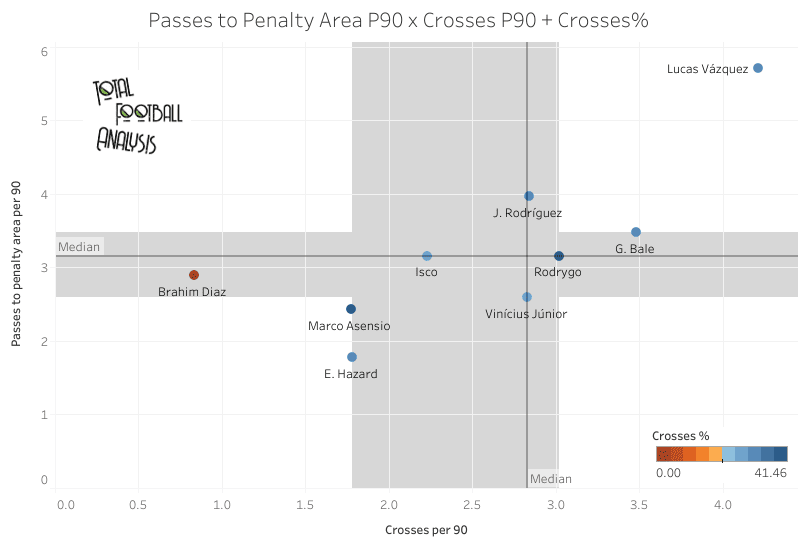
Looking first at the Madrid players, Vázquez is the top performer, sending an average of 5.71 passes to the penalty area P90, 4.21 crosses and a solid 29% success rate. James and Bale each nudged ahead of the pack in one category while offering average production in the other. Rodrygo (3.02/3.16) and Vinícius Júnior (2.59/2.83) were very balanced in their output with Rodrygo’s 41.46% crossing success rate topping the group.
Hazard, Asensio and Isco are an interesting cluster. Whereas the others, minus James, are fairly standard wingers, these three are less likely to cross the ball, that despite quality success percentages. In fact, Asensio’s 2.43 passes into the penalty area and Hazard’s 1.78 show that they’re less likely to play a teammate into the box. This season, Isco generally sent his passes before the box, whereas Hazard and Asensio were more likely to either dribble in themselves or to be the recipient of the pass into the penalty area.
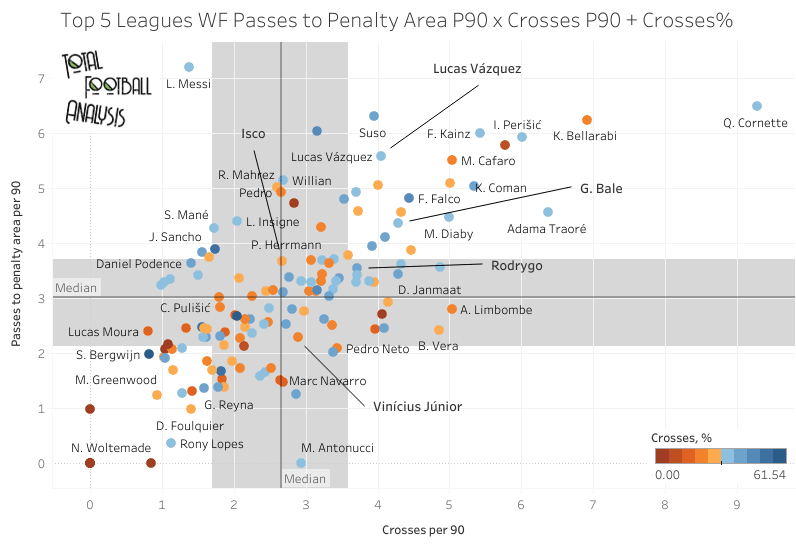
Viewing the Madrid forwards in relation to the rest larger player pool, Vázquez and Bale, followed by Rodrygo, aren’t far from the upper echelon of the dataset. Isco is above average in passes to the penalty area P90 (3.16) and average in crosses P90 (2.23) while Vinícius Júnior rated just above average in crosses per 90 (2.83) and a little below average with a 28% success rate.
Playmaking
Our next area to investigate is the playmaking ability of the group. Hazard, Isco, Bale and Asensio are well-known for their playmaking ability, but did it show in 2019/20?
The metrics we’ll use to evaluate playmaking ability from the wide forward positions are progressive runs viewed in relation to shots P90 and touches in the box P90. The objective here is to see which players are making runs behind the lines, creating opportunities with an awareness of where and when to run. Rather than focusing on the distribution end of the playmaking, we’re going to focus on the recipient’s end of the action.
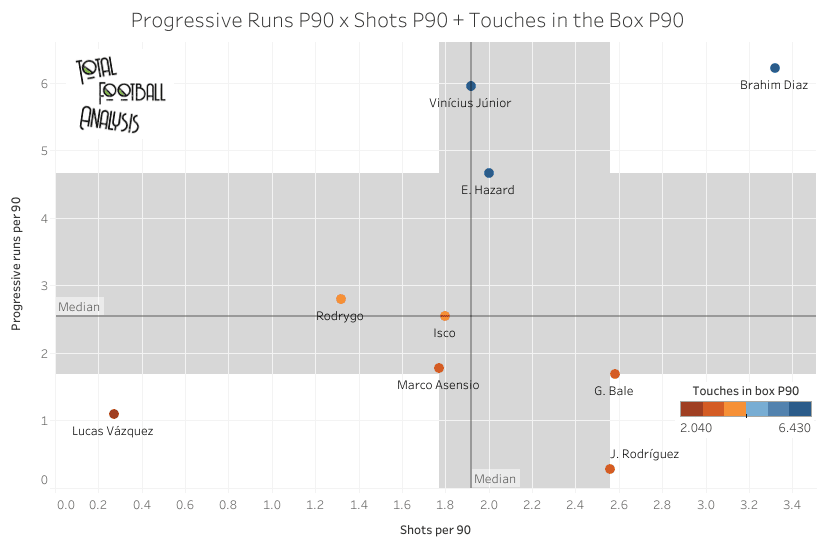
Díaz makes another showing as the outlier on the list. His presence on the top right quadrant confirms what we saw in matches. When he’s on the pitch, he’s very active and knows how to get into the box. His 6.22 progressive runs beat the 5.95 of Vinícius Júnior, and 3.32 shots P90 easily surpasses the 2.58 of Bale and 2.56 of James. Díaz’s 5.81 touches in the box P90 are third to the 6.43 of Vinícius Júnior and Hazard’s 6.12.
While Vinícius Júnior is a standout in this chart, it worth noting Hazard’s total contribution. He scores incredibly well in all three categories. If there’s a way for Zidane to get both Vinícius Júnior and Hazard on the pitch at the same time, especially given their unique, complementary skill sets, opponents could have a two-headed monster on their hands.
The last items worth noting are the high shot frequencies of Bale and James, each around 2.5 P90, the reasonably strong performance of Isco and Rodrygo in the progressive runs stat and Rodrygo’s lack of shots P90.
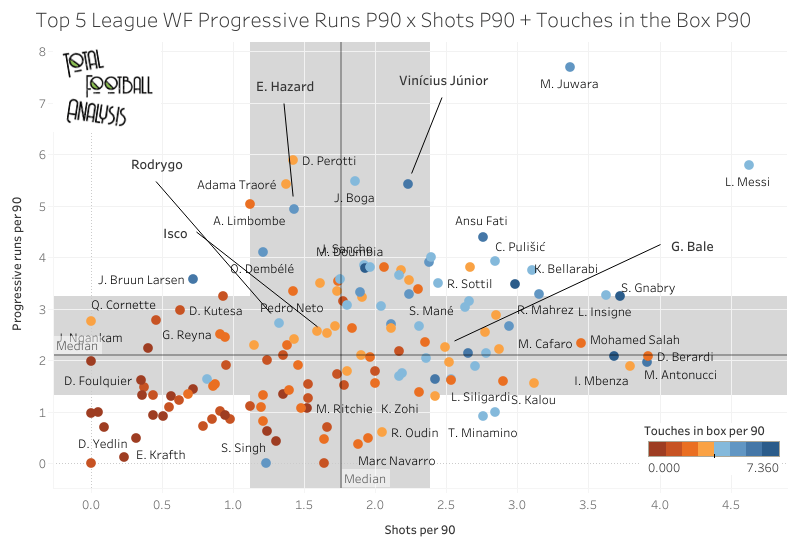
Relative to wingers in the top five leagues, Vinícius Júnior is in elite standing. Hazard’s progressive runs are elite, but touches in the box P90 are only above average and his shots P90 are below average.
Bale just sneaks into the top right quadrant, but Isco and Rodrygo put in below-average performances in the shots category, keeping them out of the preferred quarter of the board. It’s worth noting that Vinícius Júnior, Hazard and Rodrygo finish with excellent touches in the box numbers. Other than that, Real Madrid performs very well in these categories, which makes the low goals, xG and xA tallies all the more mystifying.
Next up is the dribbling portion of our data analysis. Individual quality on the wings has long been a hallmark of Real Madrid’s playing philosophy. Dominant dribblers allow them to turn the corner on the first defender, pull the second defender out of the backline’s shape and creates additional running lanes in the box. Our objective is to understand dribbling frequency and success, as well as a broader look at attacking action success.
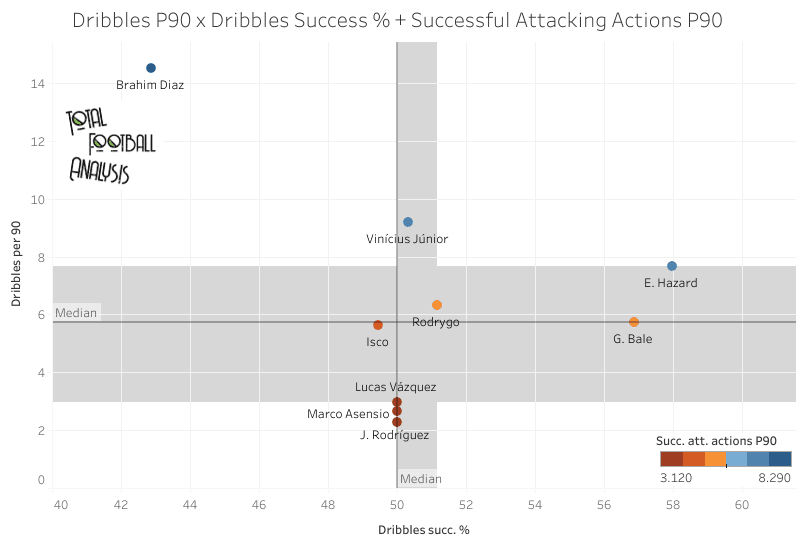
This Real Madrid side is highly engaged in the dribble. They’re led by the 7.68 dribbles P90 and 58% success rate of Hazard. He’s one of the few players in the global game who offers both high usage and success. Factor in his 6.79 successful attacking actions per game and you’ve got a highly influential player.
Vinícius Júnior isn’t far behind, contributing an incredible 9.2 dribbles P90 and 6.67 successful attacking actions P90. His 50.33% dribbling success rate leaves a little to be desired, but this is partly down to the clash of his playing style and the role of a Real Madrid left-forward. Like Ronaldo, he’s a right-footed inverted winger. Unlike Ronaldo, Vinícius Júnior prefers to dribble in the wings, challenging his opponent to the outside rather than the inside. For a right-footed player, that means he’s showing his opponent the ball as he tries to dribble pasted them. That makes it easier for the defender to win the duel. One solution is to work on his confidence and ability to drive centrally, but the simpler solution is to switch him to the right-wing. He can then protect the ball while running past the defender with his blazing pace.
Other points of emphasis are Díaz many dribbling attempts (14.52) hitting a wall with his 43% success rate. Despite the lack of dribbling success, he’s still managing a very healthy 8.29 successful attacking actions P90. Bale’s 5.73 dribbles P90 are strong, but his 57% success is one of the standout statistics on the chart. Rodrygo and Isco have fairly average numbers relative to this group.
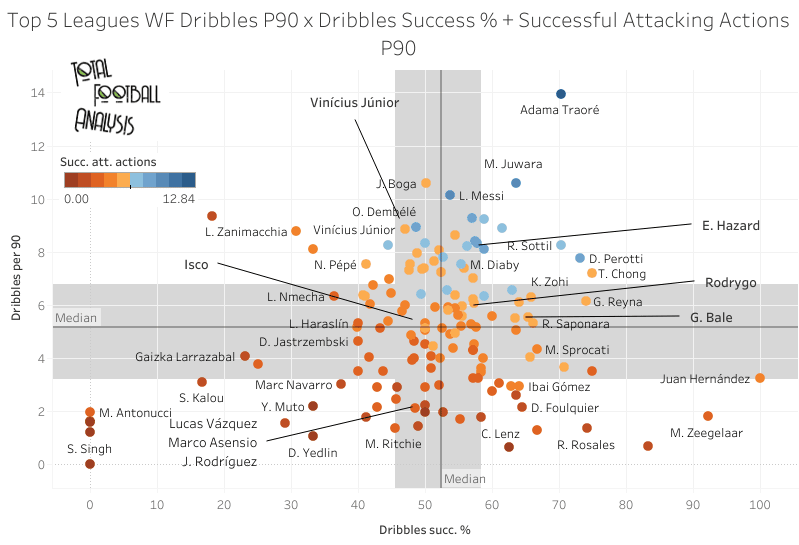
Comparing them to the larger pool of wingers, you can see Vinícius Júnior and Hazard are among the most used dribblers in the game. Bale has one of the best success rates as he, Hazard and Rodrygo make the top right quadrant, though the young Brazilian just manages to sneak into both categories. In terms of successful attacking actions, Adama Traoré skews the scale a little bit, but Hazard is still the one real standout in the Real Madrid group. Last season’s dismal attacking numbers are as much a testament to his injury issues as anything else.
Defensive quality
Finally, and this is the shortest section of the data analysis, we have a defensive quality chart. Defensive contribution is difficult to gauge, especially among forwards, but we’ll look for a general idea of defensive competence.
Take note that Real Madrid is a counterpressing side in transition with a man-marking high press scheme once the opponent establishes possession. The greatest value a forward can offer in Zidane’s system is his commitment to counterpressing. That generally doesn’t lead to quantifiable stats, such as interceptions or tackles. More often than not, the energy expenditure of the forwards leads to interceptions and aerial duels by Casemiro, Ramos and Raphaël Varane.
Still, it’s worth investigating whether the Real Madrid outside-forwards are excelling in defensive duels, possession adjusted interceptions P90 and defensive duels won percentage.
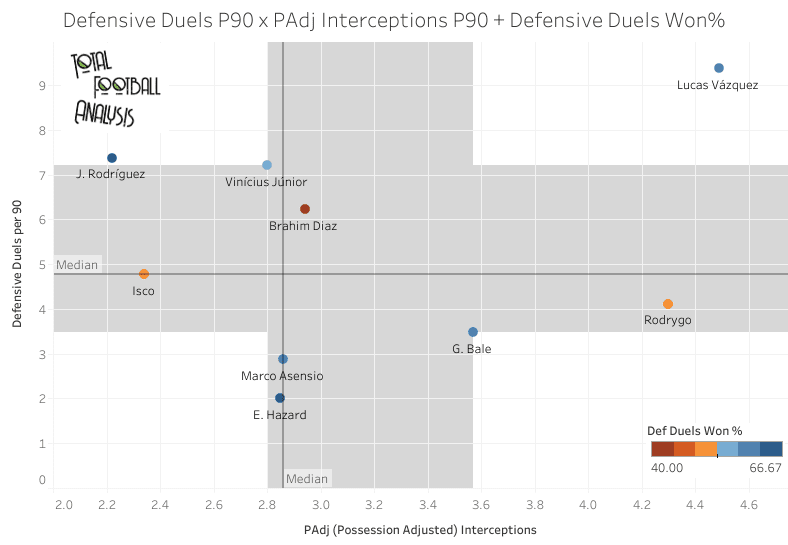
Vázquez, who earned playing time at right-back, is the clear outlier. That matches the eye test too. His 9.38 defensive duels P90 and 4.49 PAdj interceptions led the group. While his 58% success rate is only 5th in the group, you can see from his involvement alone that he’s the top defender among this forward class.
Rodrygo does well with his interceptions (4.3) but is below average in the other two categories. Moving to the other end of the graphic, James is excellent in the tackle (7.38/65%) and he’s quick to counterpress, which explains his low interceptions total.
Beyond the brilliant defensive work of Vázquez and the tackling intensity of James, Vinícius Júnior was the best overall defender among the regular starters. His 7.21 defensive duels P90 show he’s an engaged player. Add in his 57% success rate and you see he’s a great fit for Real Madrid’s pressing system. Given the lack of defensive duels from Hazard (2) and Asensio (2.87), Vinícius Júnior’s defensive contribution should keep him among the regular starters in 2020/21, even if his talented teammates manage to stay healthy.
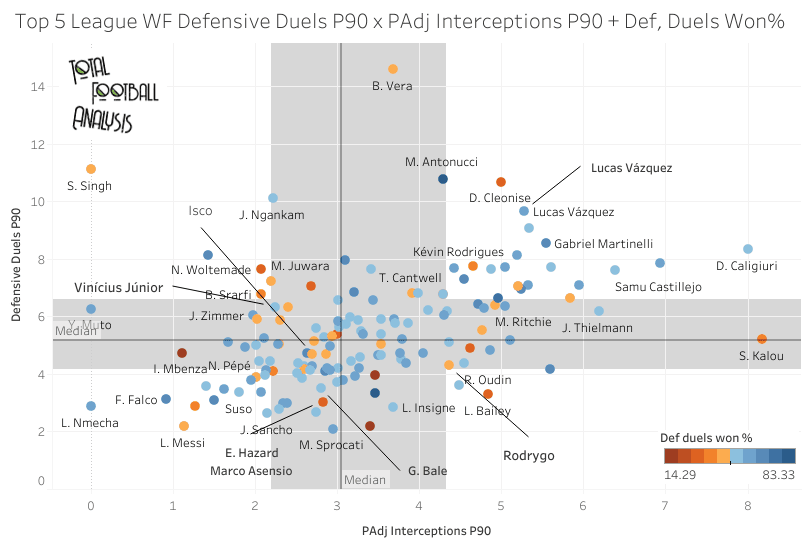
Finally, comparing the players to forwards in Europe’s top five leagues, we see very little difference between the two charts. The median lines are almost identical, so the Real Madrid players who topped the team in a specific category were also among the best across the broader player pool. This side was the best defensive team in Europe, so it’s understandable that Zidane required high levels of defensive performance from his forwards, especially given the counterpressing and man-marking high press tactics used during the 2019/20 campaign.
Conclusion
On the whole, the group performed well in the playmaking and defensive aspects of the position. Zidane is blessed with an abundance of brilliant individual attack who are committed to running behind the defence and putting in the work on the other side of the ball.
Last season’s issue was predominantly in front of goal. Whether it was a disconnect on the final pass or wastefulness in front of goal, the outside-forwards simply weren’t good enough in and near the opposition’s box. When you have a centre-forward like Benzema who likes to drop into the midfield and half spaces, the wide players have to pick up his cues and get to the goal. Hazard and Benz showed an excellent understanding of each other and Bale is certainly capable of working off the Frenchman, but the younger players are still cutting their teeth in the tactics of the game.
Whether he’s at the club or not, Bale doesn’t seem to factor into Zidane’s plans going forward. If I’m another European elite, that trade-off of low to no transfer fee, but high wages is definitely something to consider. The same goes for James’ situation.
Díaz is likely to go out on loan, so that leaves Hazard, Vinícius Júnior, Isco, Asensio and Rodrygo. Martin Ødegaard could factor in here as well, though you’ll likely see him rotating with Luka Modrić in midfield. Zidane has a great problem on his hands; there’s simply too much talent to go around. If the young guys figure out his system and show a greater cutting-edge in the final third, the selection problems only intensify.
Unless Kylian Mbappé makes his highly anticipated move to Madrid this summer, which seems unlikely, it’s those five players who will fight for minutes. Hazard’s health could open the door for Vinícius Júnior to earn significant minutes on the left, especially if the young Brazilian continues to grow into his role. While I’d like to see Vinícius Júnior earn more playing time on the right, which more naturally suits his dribbling preferences, the issue is that Asensio and Rodrygo are there. Isco’s blessing and curse are that he can play any of three positions, so, while he’s likely to rotate in and out of the lineup, it’s unlikely he’ll make one of those two outside-forward positions his own.
With the low scoring output last season, Zidane will surely demand a higher level of performance from his outside-forwards. If one of them emerges as a regular goal-scorer, he’s likely to earn more regular minutes on the pitch. Health will certainly be a concern, but the overall build of the group sets them up for a positive competition for minutes.




Comments